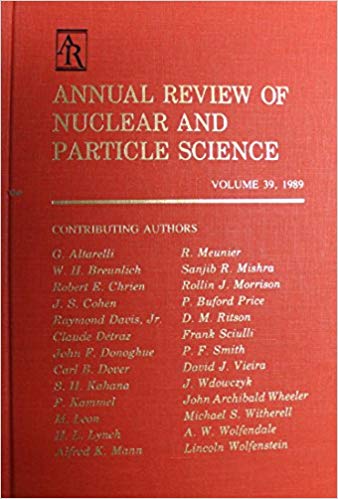晶格QCD与共振的三粒子衰变
IF 9.1
2区 物理与天体物理
Q1 PHYSICS, NUCLEAR
Annual Review of Nuclear and Particle Science
Pub Date : 2019-01-02
DOI:10.1146/annurev-nucl-101918-023723
引用次数: 103
摘要
大多数强相互作用共振都有涉及三个或更多粒子的衰变通道,包括最近发现的许多X、Y和Z共振。为了使用晶格QCD从第一性原理研究这种共振,必须理解计算中使用的立方盒中三个粒子的有限体积效应。我们回顾了发展三粒子量子化条件的努力,该条件将有限体积能量与无限体积散射振幅联系起来。我们详细描述了已经采用的三种方法,并就相应结果之间的关系提出了新的结果。我们展示了所有三种方法在数字上实施的例子,并指出了仍有待解决的重要问题。本文章由计算机程序翻译,如有差异,请以英文原文为准。
Lattice QCD and Three-Particle Decays of Resonances
Most strong-interaction resonances have decay channels involving three or more particles, including many of the recently discovered X, Y, and Z resonances. In order to study such resonances from first principles using lattice QCD, one must understand finite-volume effects for three particles in the cubic box used in calculations. We review efforts to develop a three-particle quantization condition that relates finite-volume energies to infinite-volume scattering amplitudes. We describe in detail the three approaches that have been followed, and present new results on the relationship between the corresponding results. We show examples of the numerical implementation of all three approaches and point out the important issues that remain to be resolved.
求助全文
通过发布文献求助,成功后即可免费获取论文全文。
去求助
来源期刊
CiteScore
21.50
自引率
0.80%
发文量
18
期刊介绍:
The Annual Review of Nuclear and Particle Science is a publication that has been available since 1952. It focuses on various aspects of nuclear and particle science, including both theoretical and experimental developments. The journal covers topics such as nuclear structure, heavy ion interactions, oscillations observed in solar and atmospheric neutrinos, the physics of heavy quarks, the impact of particle and nuclear physics on astroparticle physics, and recent advancements in accelerator design and instrumentation.
One significant recent change in the journal is the conversion of its current volume from gated to open access. This conversion was made possible through Annual Reviews' Subscribe to Open program. As a result, all articles published in the current volume are now freely available to the public under a CC BY license. This change allows for greater accessibility and dissemination of research in the field of nuclear and particle science.

 求助内容:
求助内容: 应助结果提醒方式:
应助结果提醒方式:


